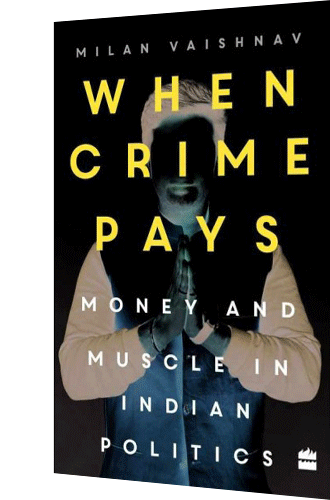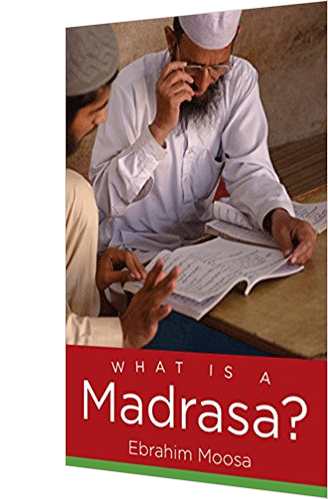When Crime Pays: Money and Muscle in Indian Politics, Milan Vaishnav, Harper Collins Publishers; Rs.1,833,
Pages 410
 At a time when Bahubali of a cinematic kind is the buzzword in India, there’s another timely intervention on the topic, but of a political kind. Milan Vaishnav’s new book claims to be the first comprehensive study of the nexus between crime and democracy in India.
At a time when Bahubali of a cinematic kind is the buzzword in India, there’s another timely intervention on the topic, but of a political kind. Milan Vaishnav’s new book claims to be the first comprehensive study of the nexus between crime and democracy in India.
The book explores the importance, capabilities and interestingly, the winnability of goondas, musclemen, criminals or as they are also sometimes called, Bahubalis, in Indian politics. The puzzle of rampant success and gradual entrenchment of politicians with criminal backgrounds in Indian politics has been frequently discussed in both academic and lay discourses.
How and why do criminals enter politics in India? Why do parties choose to nominate candidates with dubious backgrounds? Most of all, why do voters support candidates with serious criminal charges against them? These are some pertinent questions shaping the debate on the quality of democracy in India.
After General Election 2014, 21 percent of Members of Parliament had serious criminal charges against them. After the 2004 general election, this figure was around 12 percent. This includes politicians who face serious criminal charges ranging from kidnapping to abduction, threatening, intimidation and even murder. The phenomenon is seemingly more prevalent in the politics of the Hindi heartland.
However, new data provides more insightful indications in a different direction. In the recently concluded assembly elections in the largely rural state of Uttar Pradesh, around 401 or 13 percent of candidates out of a total of over 3,000, faced charges of grave criminal offences against them. In the municipal elections of Mumbai, India’s largest metro and financial capital, 9 percent of the 1,641 candidates have serious criminal charges against their names. The phenomenon of criminal politicians therefore, straddles the rural-urban divide.
So why is it that an increasingly large number of politicians with criminal backgrounds are continuously contesting elections and a good number among them winning them too? Vaishnav brings this down to two important developments in Indian politics over the years. First is the increasing predominance of money in elections. On the basis of his research, he points out that “political parties prefer self-financing candidates who do not represent a drain on the finite party coffers but instead contribute ‘rents’ to the party”. Their criminal record notwithstanding, their vast resources, which enable them to meet the rising electoral expenditure, make them electorally competitive as well.
The second development Vaishnav highlights is the wide perception among voters that politicians with criminal backgrounds can “get things done”. This is not only from the service delivery point of view. In India’s ‘patronage democracy’ (Chandra 2004) mediated access to the state is a common feature and many times these representatives are expected to facilitate informal mediation to access the resources of the state on behalf of their voters.
In his research spanning over three parliamentary elections from 2004-2014, Vaishnav found that criminal politicians have an 18 percent chance of winning the next election, while candidates with clean records have only 6 percent chance of re-election. His argument is indeed an important change in perspective of looking at state-society interactions where the rise of criminal politicians is seen as more due to illiteracy among voters than the politicians’ ability to intimidate voters (Aidt, Colden and Tiwari 2011).
According to him, “voters aren’t ignorant or uninformed; they are simply looking for candidates who can best fill a perceived vacuum of representation. Viewed in this light, the electoral success of politicians associated with illegal activity might in fact be compatible with democratic accountability, albeit of a partial nature.”
The book is divided into three parts. In the first, the author addresses the puzzle of criminality in Indian politics and attempts to contextualise the problem in the larger debate on corruption. The second part of the book emerges as the most enjoyable read, as Vaishnav undertakes the elaborate process of explaining criminality in politics. From defining the criminal enterprise in politics, to explaining the functioning of money and muscle power in elections to the demand for criminality in politics, he shows how in a given context people can actually accept criminality as an advantageous characteristic rather than an impediment in democracy.
The third and last section illustrates the idea of an election as a marketplace where criminality is shown as an attribute of certain contingent factors. Here, Vaishnav also briefly engages with evidence from other developing democracies such as Columbia, Nigeria, Jamaica and Pakistan, where the nexus between crime and politics is highly prevalent. With this brief worldwide view the author tries to give an external validity to arguments proposed in the book by keeping the writing largely free of jargon.
Apart from engaging with the ever increasing importance of crorepatis and criminals in Indian politics, the book also raises pertinent questions about external factors which aid this rise — like weak rule of law, legal loopholes, nature of party finances, ethnic attachments and indirect elections, to name a few. It triangulates data from the thousands of affidavits submitted by the candidates prior to every election over the time period 2004-14, survey data of the voters from different states as well as field interviews with bureaucrats, civil society members, politicians, police officials among others. The arguments extended in the book have therefore benefited from such multilayered analysis.
While the cinematic Bahubali is currently more in the news, because of its conclusion, Vaishnav refrains from writing any conclusion for his account of the political Bahubalis. In fact, Vaishnav’s parting thoughts on major implications that such entrenchment of crime has on the quality of democracy in India is indicative of the fact that this book is perhaps a starting point for more research on this crime and politics nexus, and can be used as a benchmark for future researchers who wish to undertake this endeavour.
It thus becomes a must-read for students, researchers and scholars who want to understand the crime and politics question better among other puzzles of Indian democracy.
Sarthak Bagchi (The Book Review, June 2017)
Madrasa reform plea
What is a Madrasa?, Ebrahim Moosa, Dev Publishers; Rs.650, Pages 290
 The word madrasa means ‘school’ in Arabic. But in South Asia and the Muslim diaspora of the subcontinent it translates into an Islamic seminary. Much has been written about madrasas in recent years. This book is different in that it provides an insider’s account of madrasa education.
The word madrasa means ‘school’ in Arabic. But in South Asia and the Muslim diaspora of the subcontinent it translates into an Islamic seminary. Much has been written about madrasas in recent years. This book is different in that it provides an insider’s account of madrasa education.
South African-born Islamic scholar Ebrahim Moosa came to India in 1975 and spent six years studying in the country’s most reputed madrasas. Currently professor of Islamic studies at the University of Notre Dame (USA), Moosa combines his intellectual explorations of Islamic theology from recent visits to madrasas in South Asia, and interviews with leading Muslim scholars to provide an engaging portrayal of contemporary madrasa education.
A useful primer on the multiple roles these institutions play in the cultural, intellectual and religious lives of Muslims, past and present, the book focuses on some core features of madrasas, especially the Sunni schools. Moosa takes us behind the walls of these sanctuaries into their classrooms, depicting the daily life of students. According to him, everyday activities in a madrasa — including prayers, classes, discussions and recreation — are “all viewed as part of a seamless pursuit of worship and the inculcation of piety”. Underlying the philosophy of madrasa education is the cultivation of qualities of the heart. Knowledge is prized as a means for spiritual transformation and as an antidote to sin.
Yet, once they graduate these students also have to accommodate change to secure employment. “The debate over whether knowledge has two roles, both for worldly flourishing and after-worldly salvation, remains unresolved in madrasa circles,” writes Moosa. Many traditionalists focus only on the former, limiting madrasa learning to the study of religious texts.
However, in the Muslim past, Moosa says worldly learning enjoyed great prestige. He hopes that latter-day madrasas would revive this lost tradition of holistic understanding of knowledge, while noting that efforts to synthesise traditional and modern knowledge in South Asian madrasas “have been largely stillborn”.
“Experiments to integrate multiple knowledge traditions in order to enhance the study of religious discourses have been shockingly incompetent with little to show in tangible outcomes,” writes Moosa. He rues that madrasas today, have “largely failed to find a formula where the worldly knowledge tradition is not antithetical to a personal salvation projects”.
Providing relevant religious guidance to Muslims, Moosa emphasises, requires Islamic scholars to master scriptural traditions as well as comprehend present-day social and economic realities. This necessitates significant reform of the madrasa curriculum, which presently pays scant attention to the teaching of secular subjects such as humanities, science and maths. “Little effort is invested in enabling the madrasas to fully and intelligibly engage with the lived realities of the present,” he says stressing the need for “a different literacy” including exploration of the humanities, social and physical sciences, to produce a competent theologian and an “enlightened Muslim orthodoxy”.
As someone who has straddled the cultures of orthodox Islam as well as contemporary Western education, Moosa is in a good position to provide a balanced assessment. Describing himself as “a friendly critic of madrasa education”, he highlights “its inability to provide the big picture of Islamic ideas” and “failure to effect the intellectual transformation of contemporary Muslim societies, especially in the sphere of religious thought”. Yet, madrasas he believes have the potential to transform into “repositories of classical learning and seeds for intellectual sophistication that might challenge the shallow discourses of fundamentalism and revivalism that too often passes as Islam today”. This transformation requires an enlightened approach of “pluralizing knowledge and constructively exposing Muslim religious thought to newer methods of inquiry such as critical readings of history, sociology, theological anthropology, philology, and hermeneutics using a variety of intellectual resources and tools.”
A work of great effort and detailed scholarship, this book is a fine introduction to madrasa education in the present context. But Moosa’s plea for wide-ranging madrasa reforms has a better chance of being put into action if the book is translated into Urdu and other languages with which South Asian Islamic scholars are familiar.
Roshan Shah